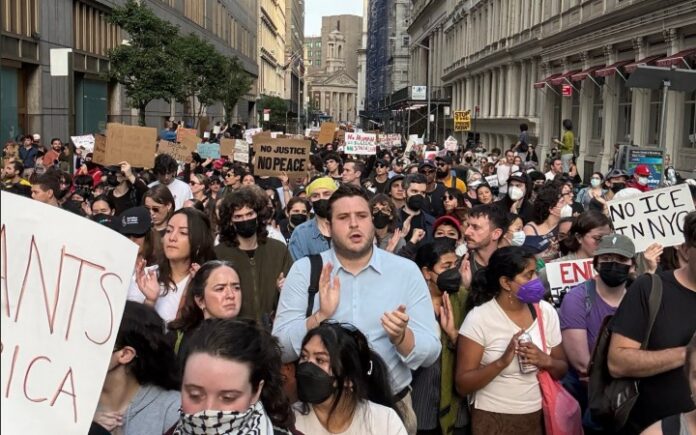As anti-ICE and anti-Trump protests are becoming increasingly frequent and newsworthy, our major news organizations need to reconsider how to cover them.
Right now, the emphasis in news reports is almost exclusively on how many people were arrested, and whether any of the protesters were violent. Even crowd estimates are oddly verboten.
See, for instance, this Washington Post report on Wednesday’s protests around the nation, which focuses almost exclusively on arrests and what the police said. Or see this New York Times report which tells us about arrests and police orders in Spokane, while saying nothing about significant protests in other cities other than they “ended with little sign of confrontation.”
Or consider that the overwhelming majority of the protesting in Los Angeles was peaceful and meaningful, but almost all you saw about it was the property damage and arrests.
I’m calling for significant rethinking in our newsrooms about how to cover protests — just in time for the massive “No Kings” protests taking place in over 2,000 locations across the nation on Saturday.
Don’t focus solely on the conflicts. Don’t focus solely on what the police say. Tell us what brought people out. Was it a range of issues or mostly just one? Tell us what some of the signs said – were they funny, angry, both? Tell us what the protesters did – did they march, chant, scream?
Were there speakers? What did they say? What are the organizers hoping to accomplish? What are their short-term goals and their long-term goals?
Describe the makeup of the crowd and give a rough indication of its size (yes you can make a reasonable estimate.) A sense of scale is crucial information.
Were the protesters young, were they old, were they diverse? Were they protest regulars or new arrivals?
When there are conflicts with law enforcement, explain how they came about rather than simply reporting how many arrests were made. Were people arrested brutally or gently? Were they arrested in an act of civil disobedience, or for an alleged crime? What crime? Was law enforcement letting people leave, or blocking them in? What did the protesters say about the arrests (not just the police)?
Don’t use words like “tensions” and phrases like “violence erupts” without explaining who created the tensions and who perpetrated the violence. Consider emulating the famous Slate headline: “Police Erupt in Violence Nationwide.”
Recognize that the overwhelming presence of heavily armed and armored law enforcement officers (and now troops!) is more likely to incite a crowd than quell a riot.
If there was violence, was it aimed at property or at people? (Is property damage “violence”?) Who was injured? How extensive was the violence? How representative of the crowd were the people who engaged in violence?
Was law enforcement’s use of force proportional? Or gratuitous? What were the rules of engagement? Were they reasonable? How heavily armed was law enforcement? Did they use “less than lethal” weaponry in a responsible or irresponsible manner? Talk to victims about what they were doing before they were injured.
How extensive or invasive was surveillance? Did law enforcement use drones? Whose drones?
Of course reporters should be careful, as they can become the targets of law enforcement violence themselves. There have been over 30 incidents of police violence against journalists in Los Angeles over the past several days. Some journalists were struck by rubber bullets and fired at with pepper balls; one crew of CNN journalists was briefly detained while broadcasting live.
Indeed, most of the protest-related advice from journalism organizations pertains to staying safe. As the Committee to Protect Journalists explains:
Covering protests and civil unrest may result in surveillance, arrest, and targeted attacks. Journalists should prepare their communication plans, equipment, and transportation in advance of a protest assignment in order to minimize potential risks. They should research the groups involved and adequately plan for situations that may involve tear gas, violence, or arrest. Journalists carrying digital devices into a crowd should be prepared for the devices to be broken, stolen, or confiscated.
But some groups also encourage better reporting.
Back in 2020, Press On, a southern journalism collective, published tips for journalists’ on ethical reporting on police violence and Black-led resistance. Their advice includes:
- Focus on the reasons for the protests.
- Don’t reflexively quote police without question.
- Property destruction does not equal violence.
- Avoid passive language.
- Listen to Black people.
What have I left out? Please add your advice in comments. And please send this along to any journalists you know!

Thanks for a piece that was really needed under current conditions. I’m tired of seeing burning cars and broken windows when I know there are hundreds of well meaning people who are justifiably pissed off at the policies of an attempted autocratic coup!